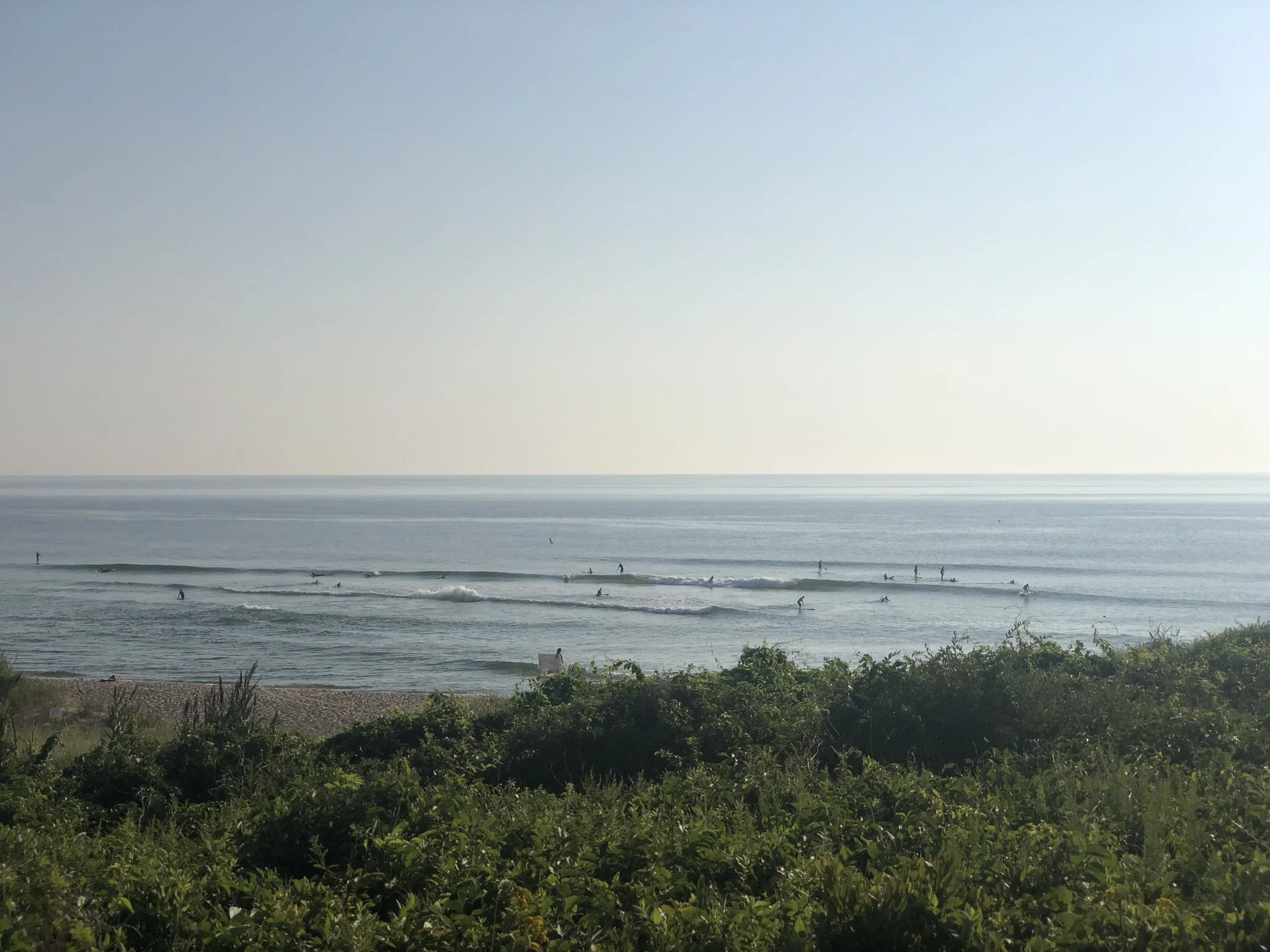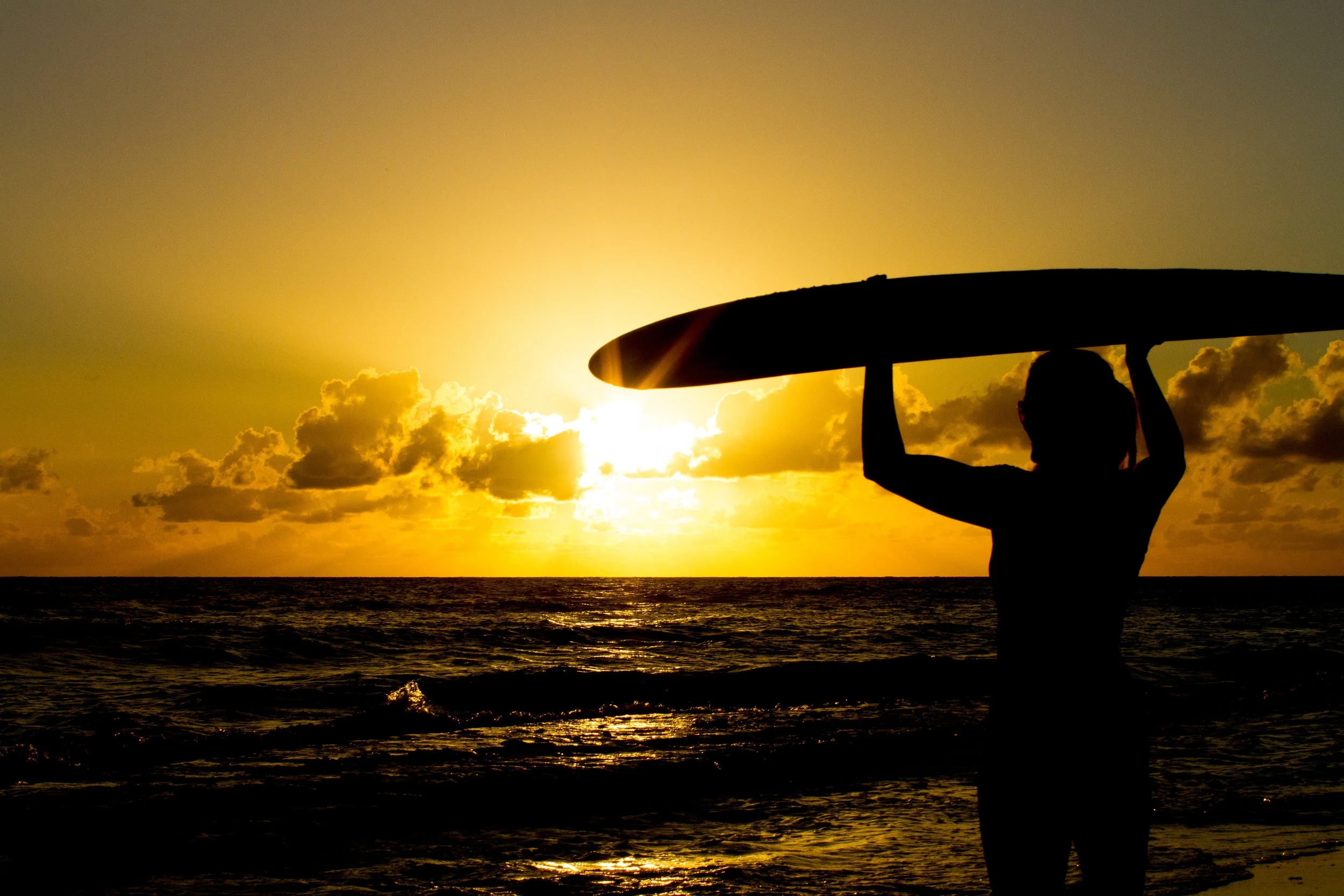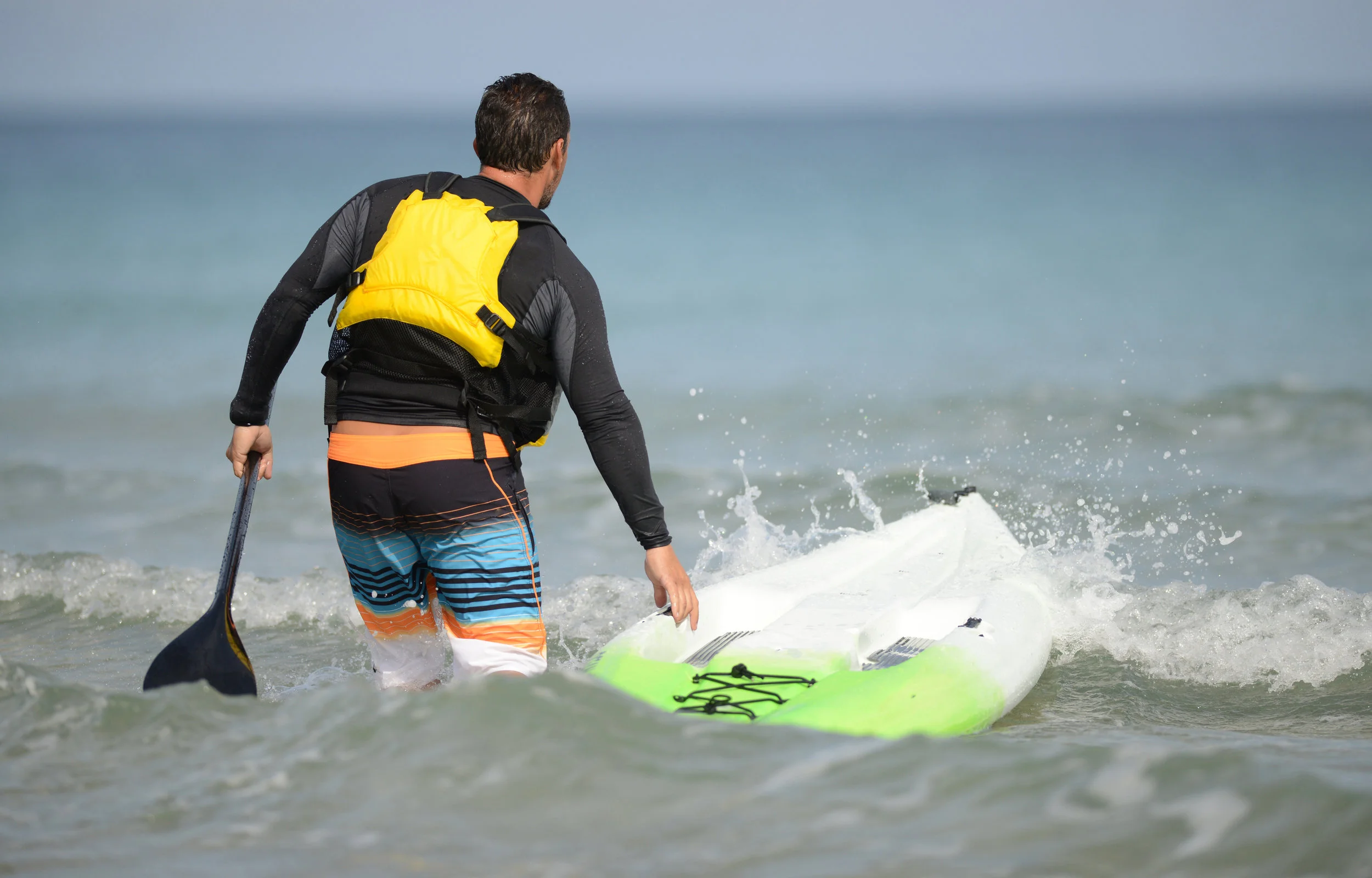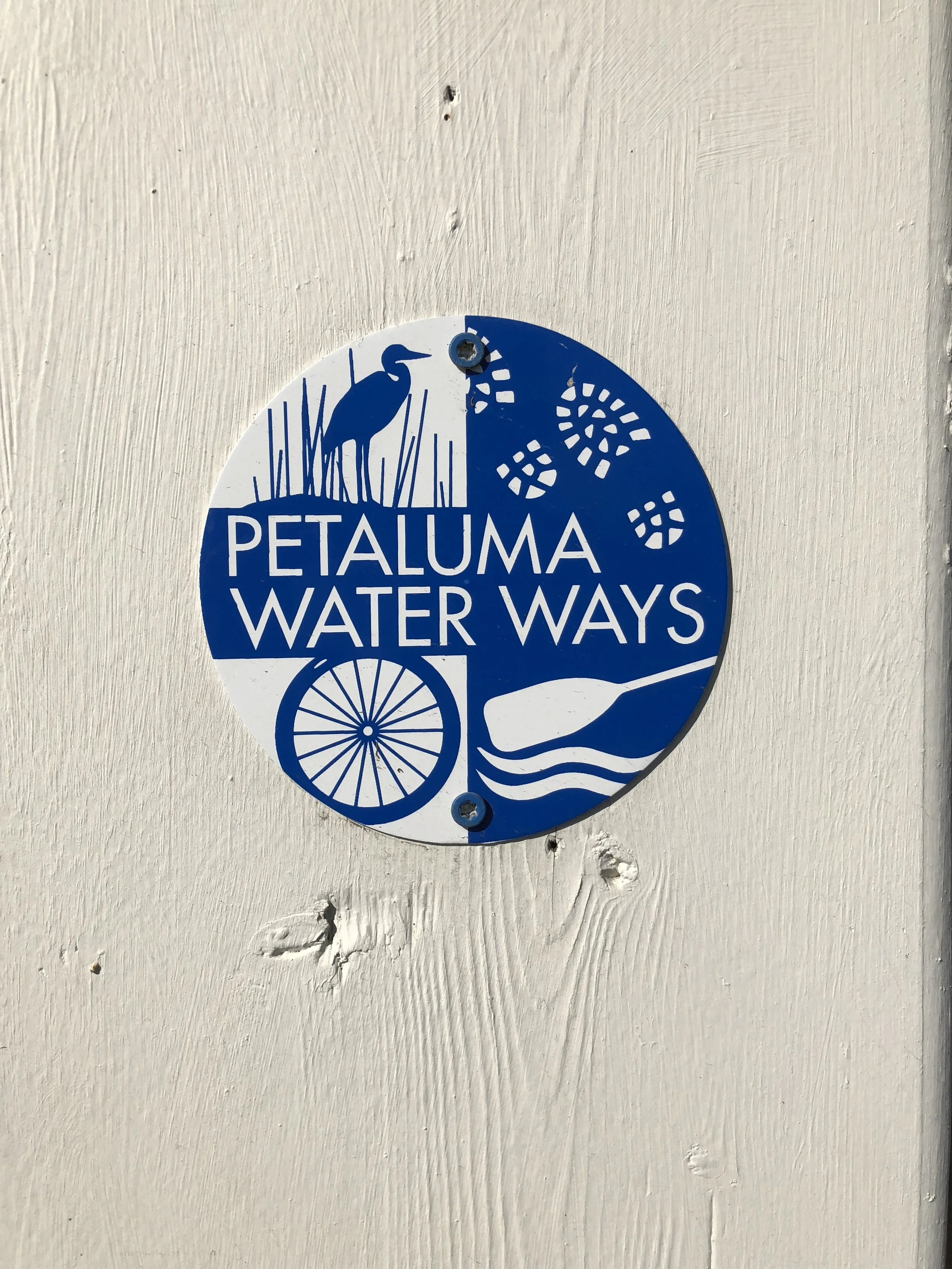
Dawn Patrol
I’ve always been an early riser and have been in the habit of exercising before dawn. There was nothing really scientific about my habit, it happened because I have four kids and there really was no other convenient time when my kids were growing up. As I surfer, I also knew the benefit of getting on the water early, typically there was less wind, and fewer people, and it was an excellent way to start the day. Now there’s new research that reinforces that getting out on the water in the golden hour has lasting benefits on your physical and mental capabilities throughout the day. The study shows that “Getting active in the morning wakes up the brain, improves concentration and gets the brain ready to learn and be productive." Plus, it fires out mood-boosting endorphins that stay with you for hours.
The silhouette on the horizon could be you. Each morning is a new opportunity to explore the water nearby. If you haven’t tried getting in a paddle before most people are awake, I highly recommend it. It is a powerful way to start the day and you’ll get a sense of accomplishment that lasts the entire day!
Finally, for those looking to lose a few extra pounds, exercising in the morning boosts your metabolism and keeps it elevated for six to 10 hours afterward—you’ll burn more calories throughout the day thanks to a morning workout. Exercising before breakfast on an empty stomach has been shown to burn a greater percentage of fat for fuel, rather than carbohydrates.
If you are looking to try an early morning paddle, and are in the San Francisco Bay Area, check out our new location in Petaluma offering storage and memberships, so you can get out on the water, easily, any time you want.
Happy Paddling
No excuses. There is water closer than you think....
Getting away from your phone and computer screen is easier than you might think. Ironically, only 5 miles from the Apple Campus, in the heart of Silicon Valley, is Stevens Creek County Park, a beautiful 1,063 acre area that offers widely diverse recreational amenities, including an 86 acre reservoir. Spending a little time outdoors for just an hour or two a week can make a significant impact on building a healthy body and positive mind set. What's more, you'd be surprised about how close a place to paddle might be to where you work or live.
One of our goals is to help more people enjoy the outdoors more often, especially close to work or home. We know first hand the wellness benefits of getting outside and experiencing a bit of nature to help you get recharged and refreshed.
Do you have a local spot that you're willing to share? Let us know!
Hope you make time to get out on the water this week.
Happy Paddling!
Sunset Summer Paddling
As the summer starts to wind down I'd encourage you to try and take a sunset paddle if you get a chance! The photo above is from Cape Cod Bay in North Eastham, MA taken at about 7:30PM. Lucky for me there were a number of folks on the beach that were nice enough to share their photos when I got off the water. I was on Cape Cod for a quick visit and arrived at Nauset Surf Shop earlier in the day during a summer thunder and lightning storm that brought over 4 inches of torrential rain in under an hour and flooded the shop's parking lot. I received some funny looks when I said I wanted to rent a SUP during this major storm - the person helping me actually took of his shoes to go outside in the rain. We managed to get the board on my rental car, but ended up soaked. There was so much water I could have actually paddled in the parking lot!
Cars trying to navigate the flooded parking lot at Nauset Surf Shop, Orleans, MA, August 9, 2018
Perhaps the reason for the spectacular sunset later that day was to make-up for the lightning and thunder that took out power and closed a section of the highway?
What started as a wild day, ended with the relaxing sunset paddle on the bay.
Happy Paddling!
bill@surfitlocker.com
Staying safe on the water
With the popularity of stand up paddle boarding growing across the ocean, rivers, and lakes, it's important to understand that, when things go wrong, they can go wrong very fast. That's why it's important that you assume a conservative and safety-conscious attitude when making decisions on the water, or even before you hit the water.
Because this is a relatively new sport, people often forget how dangerous it can be and that safety precautions have to be taken before paddling out. To help you be prepared, we’ve put together some important advice on important safety gear, weather monitoring and the different types of paddling along with some helpful suggestions so you can stay safe on the water!
One of the easiest ways to stay safe is to choose the appropriate paddling location. When you're picking your location for stand up paddle boarding, a good rule of thumb is to consider the four W's: wind, waves, water, and weather. If you're a beginner or novice paddler, you're going to definitely want to pick a location that's sheltered from both wind and waves. Otherwise, the ideal SUP environment for beginners and novice paddlers has warm water, good access for launching, lots of places to get out on shore, and minimal motorized traffic.
If you're going to be dealing with cold water, cold air, or both, you're definitely going to want to dress appropriately for the conditions.
As for safety equipment, it's important to know that stand up paddle boards are considered a vessel by the US Coast Guard. This means that you need to have a life jacket or PFD (personal flotation device) on hand if you're outside a swimming or surfing area.
1. Paddle Board Safety Gear
SUP Leash
One of the most important things to have when it comes to paddle board safety is a leash. Whether it is your first time out or you are an elite paddle boarder, this piece of equipment could make all the difference if you get separated from your board. If conditions change quickly, a leash is what connects you to your board, which is your personal flotation device that can float away from you in seconds.
The recommended leash to use is one that is a foot longer than your board, and the style depends on the water that you are paddling. If you are an ocean paddler, a straight leash is the best. This type of leash provides safety without the potential drag and tangle that might occur in turbulent white water. If you are paddling on flat water, a coiled leash is preferred since it typically stays on top of you board and will not drag in the water and slow you down. However, if you are a river paddler, you’ll need a specific type of quick release leash that prevents you from getting dragged in the event of you getting tangled in underwater rocks or branches.
PFD (personal flotation device)
The second most important item in stand up paddle board safety is a PFD. Another aspect of standup paddle boarding you should know is that the board is considered a vessel when it is used “beyond the narrow limits of a swimming, surfing, or bathing area”. In these zones, it is required by law that you wear a United States Coast Guard approved flotation device every time you paddle out past the designated “swimming, surfing, or bathing area.” Here you want to use a life jacket that provides maximum buoyancy.
Don’t be misled by many of the photos and advertising showing people on paddle boards with no safety equipment.
For more information visit the US Coast Guards, Top 10 Tips For Standup Paddle Boarding.
2. Things to Monitor Before Paddle Boarding
If you ever watch an experienced surfer before they go out in the water, they take their time and study and monitor the water, waves and wind before they jump in. Standup paddle boarding may look easy but it is important to note that it is a sport that demands awareness of dangers that may arise due to changing conditions.
Wind
The first and most important weather condition to be aware of before paddling out is the wind. Higher wind speeds create choppier waters that are dangerous for inexperienced paddlers. On days that wind speeds are high, you can find yourself battling to make any progress and balanced as opposed to paddling out to where you had planned. Therefore, it is important to check the wind forecast before paddling out. As a general rule of thumb, if the wind is traveling under 11 mph, it is typically safe for you to paddle out at any skill level. However, when wind exceeds beyond 11 mph, you should think twice before you paddle out.
Also note which way the wind is blowing as you paddle out. Is the breeze onshore or offshore? Getting blown away from shore is no fun and trying to paddle against it is a quick way to get tired and discouraged.
Swell
Swells create bigger waves and therefore harsher waters to paddle on. Getting tumbled by a wave with a paddle and board can be challenging and takes some practice. It is important to never underestimate the power of the ocean. Even if you are confident in paddling out into calm waters, waves can add a whole new level of difficulty. If a swell creates bigger waves than you are used to at your local beach, you should consider you energy level and route of paddling before you go out.
Tides
A basic understanding of tides (including rip tides or currents) and what causes them is key to ocean navigation on your paddle board. Awareness of the tides will prepare you as they can carry you very far in a small amount of time. Paddling back may take much longer than it took you to paddle out and therefore be exhausting if you don’t plan on it ahead of time. Therefore, it is important to plan your route around the tides so that you make it safely back to shore and avoid exhaustion.
Sunrise / Sunset
It is important to know the times of sunrise and sunset so that you are never paddling when it is dark. Knowledge of the times of sunrise and sunset can help you time out your paddle so that you never go out before it is light out and so you have enough time to get to shore before the sun sets.
Surfline is a great tool that has all of this information for water locations around the world.
3. Different water types
Surf
While paddle surfing, it is important to be considerate of everyone around you. Be humble and know your ability level before surfing in zones around other paddlers or surfers. The lineup is considered the “impact zone” because you are putting yourself in high danger of potential collision. Beginners should never paddle into a crowded lineup filled with other surfers, because surf skills come from experience.
To make it easier to paddle out, you can also search for the easiest way out; whether it’s a rip current to assist you to the lineup or a channel. Always use good paddle surfer etiquette by being courteous to other surfers and staying out of their way if you’re a newbie.
River
The current of a river can be fun for paddle boarders, but also dangerous as you can get dragged by it once tangled in underwater branches. You want to avoid being submerged or dragged and you can do this by using your detachable leash in order to stay close to your paddle board, your biggest flotation device.
Paddle with friends
Paddle boarding with a friend or in a group is always a good idea because it’s more fun and much safer. It is always a good idea to use the buddy system when on the water because you never know when a sometime might happen to you. A mishap could be as little as your leash snapping off shore or something more serious. If somebody else is there when this happens, that somebody can either help you or call for help.
Final Thoughts
We hope you were able to learn some valuable safety pointers as we believe that the use of safety gear, awareness of what to monitor before paddling, and knowledge of the different water types, are the tools you need to have a safe and fun paddle board session.
Happy Paddling!
10 Epic SUP Trips You Absolutely Need to Take in a Lifetime
BY OCTAVIA DRUGHI
Are you looking for some eye candy the next time you paddle your board? Do stunning backdrops, snow-capped mountains, mangrove forests, alpine lakes, lagoons, emerald-green rivers and tropical beaches tickle your fancy? Then you’re in luck, because the world’s stand-up paddle boarding hotspots have them all!
SUP is the new rage and the fastest-growing watersport in the world. One reason for this is that learning to ride a paddle board is a breeze – almost anyone can do it 30 minutes after stepping on it. Another reason is that it allows for a lot of freedom. You are not restricted to the ocean and waves; the only limit is your imagination. You can stand-up paddle board on the nearest lake or river, even in your city if there’s a winding waterway passing through it. SUP offers the chance to become one with nature in incredibly picturesque locations, all the while ‘walking on water.’
To help you find your next SUP oasis, we’ve put together a list with the world’s most epic stand-up paddle boarding trips you absolutely need to take in your lifetime.
10. New Zealand
SUP Lake Wanaka, New Zealand - Photo by Camilla Rutherford
One of the most enchanting places in the world, culturally rich and boasting abundant wildlife and ecosystems, New Zealand is a bucket list destination. Its many lakes, rivers, beaches and bays surrounded by rocky mountains have landed it a place on our list.
Bay of Islands, New Zeland - Photo credit nztravelorganiser.com
Northland’s Bay of Islands, with a subtropical climate and warm water all year round, is one of the best places for SUP in New Zealand. Not to mention that a pod or two of dolphins might tag along for the ride. Auckland and Raglan are well-known SUP hotspots, the latter being regarded as the quintessential New Zealand surf town. If you’re looking for a true sense of adventure, head to Lake Wanaka, New Zealand’s fourth largest lake.
9. Oahu, Hawaii
You can never go wrong with the birthplace of stand-up paddle boarding – Hawaii. Sunset Beach on the north shore of Oahu is famous for its big wave surfing during winter. During summer, the waves are smaller and friendlier, just perfect for paddle boarding. Those seeking a bigger challenge can paddle from Sunset Beach all the way to Waimea Bay, a 4-mile (6.5 km) trip.
SUP Lanikai Beach, Oahu - Photo credit kailuasailboards.com
Sunny and warm Oahu has plenty of other SUP spots worth hitting, like Puaena Point, Haleiwa and Lanikai Beach, which are favorites among stand-up paddling beginners. Water temperature in Oahu is usually a pleasant 80 °F (27 °C).
8. Florida Keys
SUP Florida - Photo by Bill Dickinson
With almost the entire state surrounded by water, it is no wonder that the SUP community in Florida is flourishing. The coral cay archipelago of Florida Keys off the southern coast of the state offers literally hundreds of spots to launch your paddleboard. With a rich marine life that includes stingrays and manatees, mangrove forests, a diverse ecosystem and Caribbean-like waters, Florida Keys is an island paradise that’s best explored on a kayak or SUP.
SUP Florida Keys
Paddleboarders can take advantage of the trade winds to cover long distances. When there’s no wind, the paddleboard can be used for fishing, SUP yoga, meditation or simply gliding in a slow, laid-back pace. Back on land, Florida’s Fort Lauderdale is often referred to as the ‘Venice of the East.’ Its winding canals that empty in the Atlantic make it one of the most scenic SUP destinations in the USA.
7. Mexico
SUP Los Arcos in Perto Vallarta, Mexico - Photo credit SurfMexico.com
With over 9,000 miles (14,500 km) of coastline, azure waters and sandy beaches, Mexico is one of the best surfing destinations on the planet. Quality surf awaits on both the Pacific coast and the Gulf of Mexico, and there’s always a cool wave to catch throughout the year.
Puerto Vallarta is a culturally rich city that offers excellent SUP opportunities for all levels. Here, Banderas Bay, with its warm and calm water, is a Pacific haven. Los Muertos Beach is the most popular and active when it comes to water sports, and you can expect to see sea turtles, dolphins and humpback whales while paddling here.
Sayulita, Mexico - Photo credit lainitaylor.com
The small tropical town of Sayulita is considered the SUP capital of Mexico. Beginner and pros alike are guaranteed to have a good time, as a growing SUP community will welcome them. Cancun and Punta Mita are excellent locations too, great for the whole family.
6. Slovenia
SUP Slovenia - Photo credit sup-slovenia-discovery.com
A small country counting only two million inhabitants between the mighty Alps and the Adriatic Sea, Slovenia is one of the most water-rich countries in Europe. This can only mean one thing – a SUP paradise. Stand-up paddling is relatively new to Slovenia, but it has seen a rapid growth these past years thanks to the country’s pristine nature and numerous flat-water alpine lakes and gently-flowing rivers.
SUP Savica River, Slovenia - Photo credit supboardermag.com
In Slovenia, stand-up paddle boarding is as diverse as the country itself. There’s even urban SUP here. After all, what better way to explore the picturesque Old Town of the capital city of Ljubljana than by paddling your way through it? The unbelievably picturesque Lake Bled is on top of everyone’s list, an alpine lake that is home to Slovenia’s only island. So are paddling down the emerald-green Soča River and Savica River and on Lake Cerknica.
5. British Columbia, Canada
SUP Emerald Lake in the Canadian Rockies - Photo credit rockiesfamilyadventures.com
It may not be the first destination that springs to mind when thinking about SUP, but British Columbia (B.C.) is a hidden gem with plenty of surprises in store. After all, it is a mecca for outdoor enthusiasts and a popular destination for kayakers and canoe trippers. Why should stand-up paddle boarding fall behind?
SUP Whistler, B.C. - Photo credit gibbonswhistler.com
With lakes, rivers, a maze of waterways along the rugged central coast, no wonder B.C. has a thriving SUP community. There are so many amazing spots to paddle it would be tough to list them all. So we’ll just mention what we believe are the best – the coastal waters of Tofino, Kalamalka Lake in Vernon, Muncho Lake, Emerald Lake, Whistler and the west side of Vancouver are the places to start for a scenic SUP adventure.
4. The Turks and Caicos Islands
SUP Turks and Caicos Islands - Photo credit tropicalwavestci.com
An archipelago of 40 coral islands surrounded by turquoise waters, the Turks and Caicos Islands are an SUP haven. Explore the mangrove swamps and reefs abounding in sea turtles and schools of colorful fish, all the while watching herons and nurse sharks swimming underneath your board.
SUP Turks and Caicos Islands - Photo credit bigblueunlimited.com
Turks and Caicos Islands have an average water temperature of 80 °F (27 °C) and see the most tourists between December and March. There’s no better way to explore the pristine wetlands and hidden turquoise waterways of the islands than on a SUP. The calm waters and white sand beaches make Grace Bay a paddle boarding paradise. Chalk Sound National Park and its landlocked lagoon is another picturesque spot to paddle.
3. Portugal
SUP Ericeira, Portugal - Photo credit surfholidays.com
Often referred to as the stand-up paddle boarding capital of Europe, Portugal does indeed offer a wide variety of waters. With 1,115 miles (1,794 km) of coastline, there’s a huge potential for surfing, SUP and other watersports. Even better, there are plenty of top-notch SUP spots within striking distance from the country’s capital. One of them is the popular seaside resort of Ericeira.
Almourol Castle, Rio Tejo, Portugal
Paddle the majestic Rio Tejo, which empties into the Atlantic at Lisbon – there aren’t many places in the world where you can SUP round an 800-year-old Knights Templar Castle. South of Lisbon, Luiz Saldanha Marine Park offers a unique experience – it is like paddling in an aquarium with more than 1,000 species, with an astounding visibility of up to 70 feet (21 m). The turquoise waters here have quite a few bottlenose dolphins as permanent residents. For a change of scenery, take a SUP ride inside the Benagil Cave in the Algarve.
2. Costa Rica
SUP Nosara, Costa Rica - Photo credit experience-nosara.com
There’s no doubt that Costa Rica is a surfing mecca that’s on everyone’s bucket list. But I’m here to tell you that stand-up paddle boarding is gaining serious ground on the tropical country’s coasts too. Tourists who do not fancy the idea of spending days in a row learning to catch a wave now have the perfect alternative – SUP.
SUP Playa Danta, Costa Rica - Photo credit lascatalinascr.com
Playa Danta in the Guanacaste region is a secluded, off-the-beaten-path flat-water bay abounding in exotic sea life. It is also one of the country’s premier SUP spots. There’s more to Playa Danta than surfing. For adventure lovers, there are zip lines and ATV rides through the surrounding jungles. And please make sure you bring your snorkeling gear along. With water temperatures ranging around 86 F (30 C) all year, Costa Rica truly is a paradise found.
1. Lake Tahoe, California
SUP Lake Tahoe - Photo credit californiahome.me
North America’s largest alpine lake is perhaps the most photographed SUP location in the world. And with good reason – its mesmerizing blue water, 72 miles (115 km) of shoreline covered in coniferous trees and the snow-capped Sierra Nevada Mountains in the background make it a dream destination for a variety of recreational activities. What better way to enjoy this natural beauty than on a laid-back paddle boarding session?
SUP Lake Tahoe - Photo credit standuppaddletahoe.com
The crystal-clear waters of Lake Tahoe offer an astounding visibility of up to 70 feet (21 m) down on a good morning. Conditions are great from late spring until early fall, and the best time of day to paddle is in the morning or early evening. That’s when the surface is calmer and the winds are gentle, ensuring an intimate experience. These conditions are also ideal if you’re a beginner. Lake Tahoe is the venue of the annual Tahoe SUP & Paddleboard Race Series, an annual event worth attending if not even participating in.
Would you like to take your stand-up paddleboard around the world? Now you know where to start! So head to BookSurfCamps.com and choose your next SUP holiday.
Octavia writes for BookSurfCamps.com, the largest surf travel website with 2056 unique listings in 244 destinations around the world.
Discover Surf Camps now
Undiscovered Water
I've lived in the San Francisco Bay Area for over 50 years and consider myself pretty well traveled and familiar with places to paddle and surf in Northern California. How wrong I've been. Since starting to paddle board about five years ago, I've been amazed at the number of new spots and places to be discovered - not to mention the great people I've met along the way that have helped guide me!
During the Summer we plan to document and share some of the best spots we've found. I know not everyone reading this is in Northern California, so we also plan to highlight and add other locations as well. Please feel free to send a note if you have a favorite spot to share that you'd like us to highlight.
Early morning Paddle in the Napa/Sonoma Marshes Wildlife Area - Entry Point: Hudeman Slough Launch
One recent discovery is the Napa-Sonoma Marshes Wildlife Area, approximately 15,200 acres of baylands, tidal sloughs and wetland habitat. Most of the area is accessible only by boat or paddling, though some areas can be accessed from land.
Originally one of the richest wetland ecosystems in the nation, the San Francisco estuary once comprised over 4,600 square miles of habitat ranging from open water mud flats to tidal salt, brackish, and fresh water marshes to associated upland grasslands and riparian areas. This area was of global importance to the millions of migrating shorebirds and waterfowl that used it, as well as the resident populations of mammals, fish, and crustaceans. Unfortunately, since the first Spanish explorers arrived, over 90% of these wetland habitats have been dramatically altered or destroyed. At the northern edge of San Pablo Bay, the Napa, Sonoma, and Solano County tidal marshes have changed from an area once over 90 square miles to less than 50,000 acres presently. You can learn more about the area here.
Public Boat Launch Ramps:
Vallejo: next to Brinkman's Marine
Hudeman Slough: in Sonoma County, on Skaggs Is. Road, 1 mile south of Ramal Road
Cuttings Wharf: in Napa County, on Cuttings Wharf Road, south of State Hwy 12/121
You'll be amazed by the many sloughs that circulate through the interior of the marsh. Be sure to consult local tide tables for the best (and most safe) paddling opportunities to tour the area. Also please be aware of hunting activity during the months of October through January each year.


































